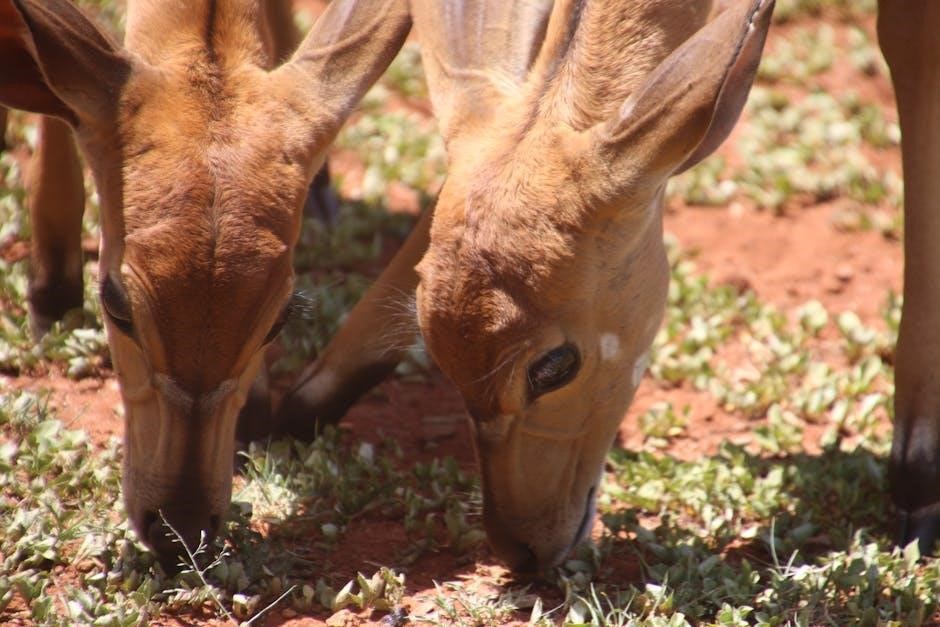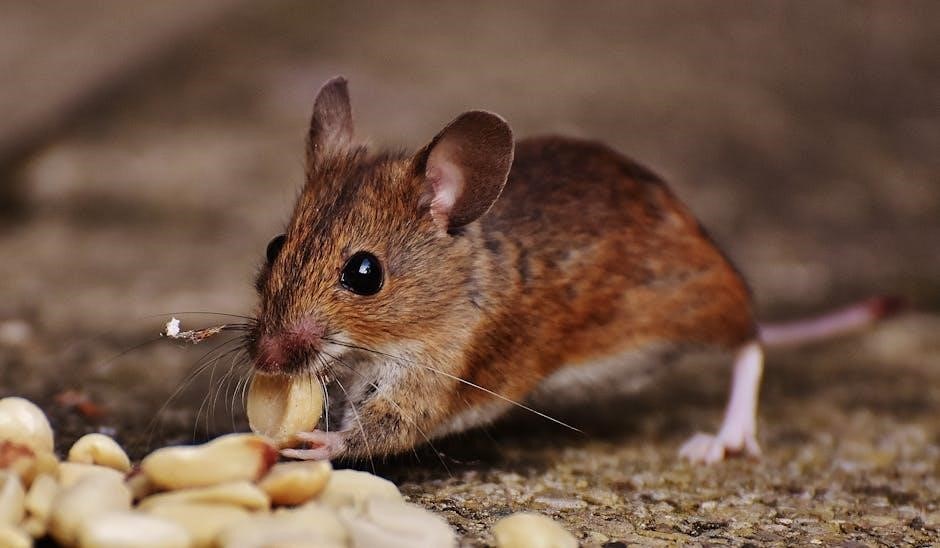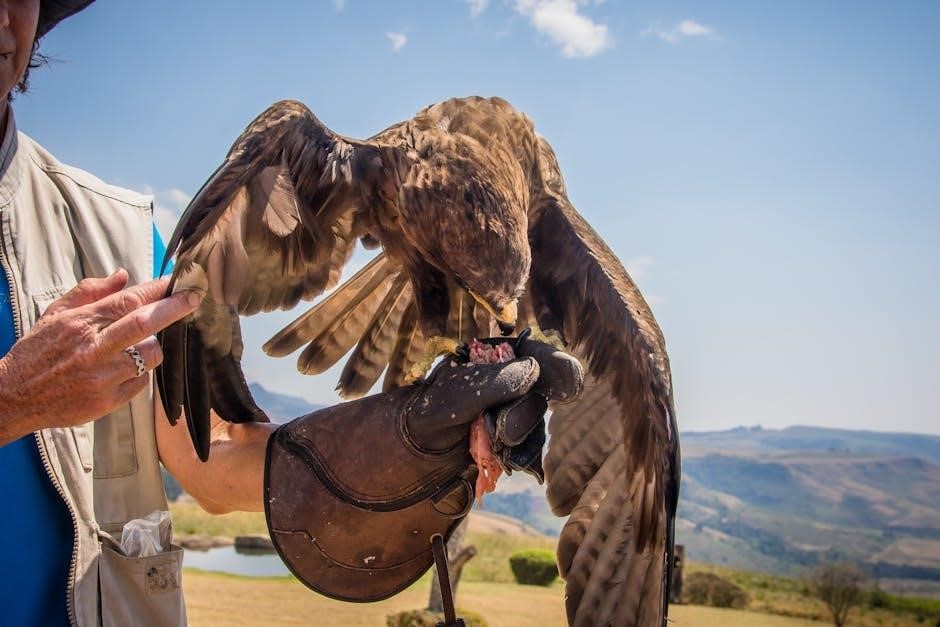feeding guide taste of the wild
Welcome to the Taste of the Wild Feeding Guide, your comprehensive resource for optimizing your pet’s nutrition․ This guide helps pet owners provide balanced, nutrient-rich meals tailored to their dog’s specific needs, ensuring optimal health and vitality․ By focusing on high-quality ingredients and tailored feeding strategies, it supports overall well-being and longevity․
1․1 Overview of Taste of the Wild Dog Food
Taste of the Wild dog food is inspired by the diet of wild wolves, offering high-quality protein sources like real roasted meats․ It is grain-free and features limited ingredients to reduce the risk of food sensitivities․ This nutrient-rich formula supports energy, digestion, and overall health, catering to dogs of all life stages and lifestyles with its natural, wholesome approach to pet nutrition․
1․2 Importance of Proper Feeding for Pets
Proper feeding is essential for maintaining your pet’s health, energy levels, and overall well-being․ A balanced diet ensures optimal nutrient intake, supporting immune function, digestion, and vitality․ Incorrect feeding can lead to weight issues, allergies, or health problems․ Tailoring meals to your pet’s needs helps prevent these issues, promoting a long, healthy life and strengthening the bond between you and your pet․

Nutritional Philosophy of Taste of the Wild
Taste of the Wild prioritizes high-quality protein sources and natural ingredients, mirroring a dog’s ancestral diet․ This approach ensures optimal nutrition, supporting energy, digestion, and overall health․
2․1 High-Quality Protein Sources
Taste of the Wild emphasizes real roasted meats as primary ingredients, ensuring dogs receive essential amino acids for muscle growth and energy․ These high-quality proteins, such as venison, salmon, and lamb, are easily digestible, reducing the risk of digestive issues․ This approach aligns with a dog’s natural diet, promoting lean muscle structure and overall vitality․
2․2 Grain-Free and Limited Ingredient Diets
Taste of the Wild offers grain-free and limited ingredient diets to cater to dogs with food sensitivities․ These recipes focus on real roasted meats as the primary ingredient, avoiding fillers like corn and wheat․ This approach reduces the risk of allergic reactions and promotes easier digestion․ The limited ingredient diets are balanced with essential vitamins and minerals, ensuring a nutritious and natural meal for your pet․

Feeding Guide Basics
Understand the fundamentals of feeding your dog with Taste of the Wild․ This guide provides essential tips on portion sizes, feeding schedules, and adjusting based on factors like weight, age, and activity level to ensure your pet’s nutritional needs are met․
3․1 Determining the Right Portion Size
Determining the right portion size for your dog involves considering their weight, age, and activity level․ Use Taste of the Wild’s feeding charts as a starting point and adjust based on your dog’s individual needs․ Monitor your dog’s condition and consult your veterinarian to ensure portions are balanced and meet their nutritional requirements for optimal health․
3․2 Feeding by Life Stage (Puppy, Adult, Senior)
Feeding requirements vary by life stage․ Puppies need high-protein diets for growth, while adults require balanced nutrition for maintenance․ Seniors may benefit from reduced calories and added joint support․ Tailor your dog’s meals to their life stage, ensuring optimal nutrition at every phase․ Adjust portions as needed to support their energy levels and overall health throughout their life․
3․3 Adjusting for Activity Level and Lifestyle
Active dogs require more calories to sustain energy, while less active dogs need fewer to prevent weight gain․ Monitor their intake and adjust portions accordingly․ Consider their lifestyle—working dogs, indoor pets, or seasonal changes․ Tailor their diet to meet specific needs, ensuring balanced nutrition․ Consult a vet for personalized advice to maintain optimal health and vitality․
Transitioning to Taste of the Wild
Transitioning your pet to Taste of the Wild requires a gradual approach to prevent digestive upset․ Start with small portions, mixing with their current food, and increase the ratio over 7-10 days․ Monitor their response and adjust as needed to ensure a smooth switch and maintain their health and energy levels․
4․1 Gradual Switching to Prevent Digestive Issues
When transitioning your dog to Taste of the Wild, start by mixing a small portion with their current food․ Gradually increase the ratio over 7-10 days to allow their digestive system to adjust․ This approach minimizes the risk of upset stomachs and ensures a smooth transition․ Always monitor your pet’s response and adjust the pace if needed to maintain their comfort and health․
4․2 Monitoring Your Pet’s Response
Observe your dog’s behavior, digestion, and energy levels during the transition․ Watch for signs of discomfort, such as upset stomach or lethargy․ If issues arise, slow the transition pace or consult your veterinarian․ Ensure your pet’s stool quality remains normal and their appetite stays consistent․ Adjustments may be needed based on individual tolerance to achieve a seamless switch to Taste of the Wild․

Feeding Frequency and Schedule
Taste of the Wild recommends feeding adult dogs twice daily, while puppies may need three meals․ Optimal feeding times are morning and evening for routine․ Consistency supports digestion and steady energy levels․ Adjust frequency based on age, size, and activity level․
5․1 How Often to Feed Your Dog
Feeding frequency depends on your dog’s life stage, size, and activity level․ Puppies typically require 3-4 meals daily, while adult dogs thrive on 2 meals․ Senior dogs may need fewer, depending on mobility and metabolism․ Consistency is key to maintaining digestion and energy levels․ Adjust frequency based on individual needs and consult your vet for personalized advice․
5․2 Best Times of Day for Meals
Feeding your dog at consistent times daily helps maintain their energy levels and digestion․ For most dogs, morning and evening meals work best, aligning with their natural activity rhythms․ Puppies may benefit from midday meals, while seniors might thrive on a more relaxed schedule․ Always coordinate feeding with exercise to prevent digestive issues like bloat․ Consistency is key for a healthy routine․
Special Dietary Needs
Addressing allergies, sensitivities, and weight management is crucial․ Tailored feeding plans ensure your dog’s unique needs are met, promoting optimal health and preventing potential health issues effectively․
6․1 Managing Food Allergies or Sensitivities
Identifying and addressing food allergies or sensitivities is essential for your dog’s health․ Common allergens include beef, dairy, or soy․ Introduce novel protein sources like venison or salmon gradually․ Monitor your dog’s response, such as skin health or digestion․ Consult your veterinarian for tailored advice and consider limited ingredient diets to minimize reactions and ensure your pet thrives․
6․2 Weight Management Tips
Maintaining a healthy weight is crucial for your dog’s longevity and well-being․ Measure food portions accurately and avoid overfeeding․ Incorporate regular exercise, such as walks and playtime․ Consider calorie-controlled diets and monitor progress․ Consult your vet for a personalized plan to ensure your pet stays at an ideal weight, reducing the risk of obesity-related health issues for a happier, healthier life․
Common Feeding Mistakes to Avoid
Avoid overfeeding and ignoring serving size guidelines, as this can lead to obesity and health issues․ Ensure meals are balanced and tailored to your dog’s needs and activity level, consulting a vet for personalized advice to prevent common feeding errors and promote optimal health․
7․1 Overfeeding or Underfeeding
Overfeeding can lead to obesity and related health issues, while underfeeding may result in malnutrition․ Monitor your dog’s weight, energy levels, and adjust portions accordingly․ Ensure meals align with their activity level and life stage․ Avoid free-feeding; use the guide’s portion recommendations․ Consult a veterinarian if unsure, as improper feeding can affect long-term health and well-being․
7․2 Ignoring Individual Needs
Every dog has unique needs based on size, breed, age, and health conditions․ Ignoring these factors can lead to digestive issues or nutrient deficiencies․ Consider activity levels and any allergies when feeding․ Tailor portions and ingredients to your dog’s specific requirements for optimal health․ Consult a veterinarian for personalized advice to ensure your pet’s dietary needs are met effectively․

FAQs and Troubleshooting
Frequently asked questions about feeding your pet are addressed here, offering solutions to common issues like digestion problems or weight management․ Troubleshooting tips help ensure your dog thrives on their diet․
8․1 Addressing Common Concerns
Addressing common concerns ensures your pet’s dietary needs are met․ Issues like digestion problems or weight gain can be resolved by adjusting portion sizes or ingredient balance․ Monitoring your dog’s response and consulting a veterinarian if concerns persist is crucial․ Regular check-ups and tailored advice help maintain their health and well-being, ensuring the feeding guide is effectively utilized for optimal results and peace of mind for pet owners․
8․2 When to Consult a Veterinarian
Consult a veterinarian if your dog experiences digestive issues, allergies, or significant weight changes while following the Taste of the Wild feeding guide․ They can provide personalized advice tailored to your pet’s specific needs and health conditions․ Regular check-ups ensure your dog’s diet aligns with their overall well-being, addressing any concerns promptly for long-term health and happiness․
Adhere to the Taste of the Wild feeding guide for a balanced diet, monitor your dog’s health, and consult a vet for personalized advice․ Stay informed about pet nutrition to ensure your dog thrives, maintaining their well-being and longevity with proper feeding practices and regular check-ups․
9․1 Maintaining a Balanced Diet
Maintaining a balanced diet is crucial for your dog’s health․ Ensure meals are rich in high-quality protein, whole ingredients, and essential vitamins․ Avoid overfeeding or underfeeding by following portion guidelines․ Monitor your dog’s weight, energy levels, and overall health․ Adjust their diet as needed based on life stages or activity levels․ Regular veterinary check-ups can help confirm your dog is thriving on their current diet plan․
9․2 Staying Informed About Pet Nutrition
Stay informed about the latest in pet nutrition to make the best choices for your dog․ Research high-quality ingredients, understand food labels, and consult with veterinarians for personalized advice․ Follow trusted sources like veterinary recommendations and manufacturer guidelines to ensure your dog’s diet remains balanced and meets their evolving needs․ Regular updates on nutritional research can help you adapt their diet for optimal health and longevity․

